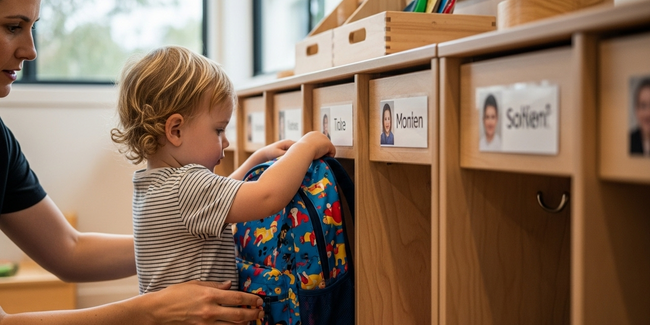After more than 15 years in early childhood education, we’ve had the privilege of guiding hundreds of Sunshine Coast families. In all that time, one of the most misunderstood yet powerful tools in a child’s development is the simple concept of routine.
Often, parents worry that routines are about rigid schedules and control—that they might stifle the very creativity and spontaneity we want to nurture in our children. But our extensive experience, backed by decades of developmental neuroscience, has shown us the opposite is true. Routines are not cages; they are the invisible architecture that builds a child’s sense of security, confidence, and freedom to learn.
When done thoughtfully, routines offer more than just structure—they show respect for the brain’s growth. They are the consistent, loving answer to a child’s unspoken question: “What happens next?” When a child knows the answer, their mind is freed from anxiety and becomes available for the deep, meaningful work of play and discovery. This article is our guidance on the ‘why’—the deep science that transforms a simple daily rhythm into a foundation for lifelong success.
The Neuroscience of Predictability: Calming the Brain to Ignite Learning
To understand the power of routine, we must first look inside the developing brain. A young child’s brain is a remarkable engine of growth, but its “air traffic control system”—the prefrontal cortex, responsible for emotional regulation, planning, and focus—is still under construction. When a child’s day is chaotic and unpredictable, this developing system is flooded with the stress hormone cortisol. The brain is forced to spend its precious energy just trying to feel safe.
Predictable routines act as a powerful neurological buffer.
When a child knows that playtime follows morning tea, and a quiet story comes after lunch, their brain doesn’t have to work so hard anticipating potential threats or changes. This consistency creates and strengthens neural pathways for calmness and security. Think of it like walking through a dense forest. The first time, the journey is uncertain and requires immense concentration. But each time you walk the same path, it becomes clearer, wider, and easier to navigate. Routines create these well-trodden neural paths in the brain, reducing cognitive load and allowing a child to move through their day with confidence.
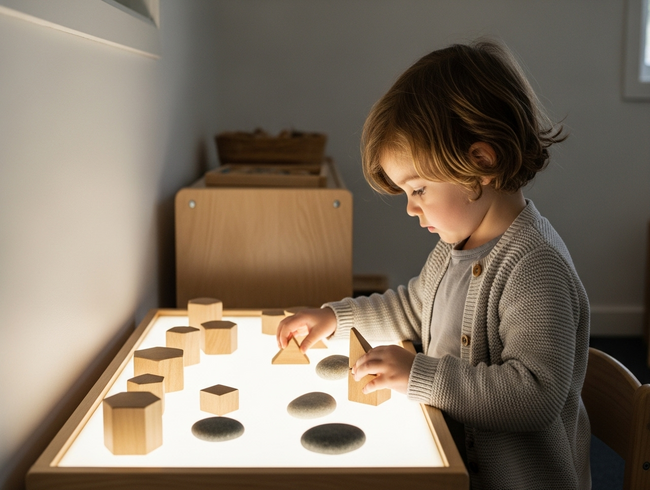
This state of calm is not just about feeling good; it is the essential prerequisite for learning. A child whose nervous system is settled is a child who is ready to be curious, to solve problems, to engage with others, and to absorb the world around them. This principle is a cornerstone of the National Quality Standard, particularly Quality Area 5 (Relationships with children), which recognises that secure and predictable environments are fundamental to children’s emotional wellbeing.
The Emotional Anchor: Building a World of Trust and Security
For a baby, toddler, or preschooler, the world can feel enormous and overwhelming. Routines provide the emotional anchors that make this big world feel manageable and safe. The consistent sequence of a drop-off—a special hug, a wave at the window, and a welcoming educator—transforms a moment of potential anxiety into a predictable ritual of connection and trust.
This predictability is the language of safety. It communicates to a child, “You are safe here. We know what you need. You can depend on us.”
This sense of security is the foundation upon which all other development is built. A child who feels secure is more willing to take healthy risks, like trying a new activity or making a new friend. They develop a stronger sense of self and belonging because they trust the world and the people in it. This aligns directly with the “Belonging, Being, and Becoming” philosophy of the Early Years Learning Framework (EYLF), where a secure sense of belonging is the first critical step in a child’s journey.
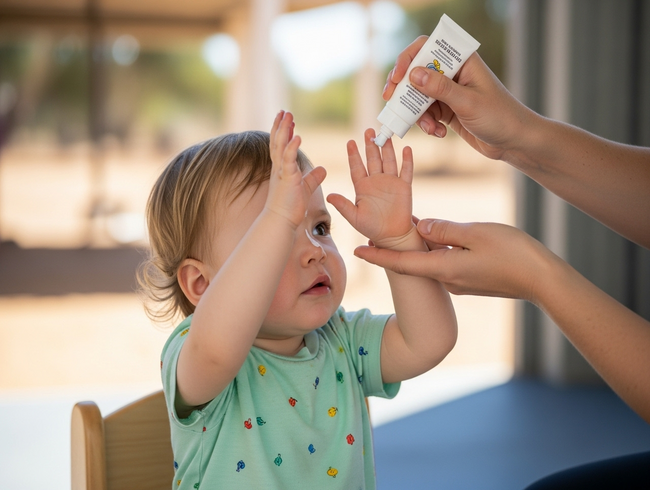
When routines are implemented with warmth and responsiveness, they become powerful moments of connection. The ritual of setting the table for lunch or singing the same pack-away song every afternoon isn’t just about efficiency; it’s about shared experience, cooperation, and reinforcing the feeling that “we are all in this together.”
From Chaos to Competence: Routines as the Scaffolding for Independence
While routines provide security, they also actively build a child’s capability. The EYLF v2.0 highlights that daily routines are rich “teachable moments,” and our experience validates this completely. Predictable sequences are a young child’s first introduction to concepts like time, order, and logic.
Consider these developmental milestones powered by routine:
- Executive Function: Following a multi-step routine like washing hands, finding a hat, and lining up to go outside builds working memory, focus, and self-control—the core components of executive function.
- Independence and Autonomy: When a toddler knows where to put their bag or that they need to put on a smock before painting, they are empowered to act independently. This fosters a powerful “I can do it!” mindset that is crucial for self-esteem.
- Self-Regulation: Routines help children learn to manage their own energy and emotions. The transition from active outdoor play to a calm, quiet storytime helps them practice down-regulating their bodies and minds, a skill that is vital for school readiness and life.
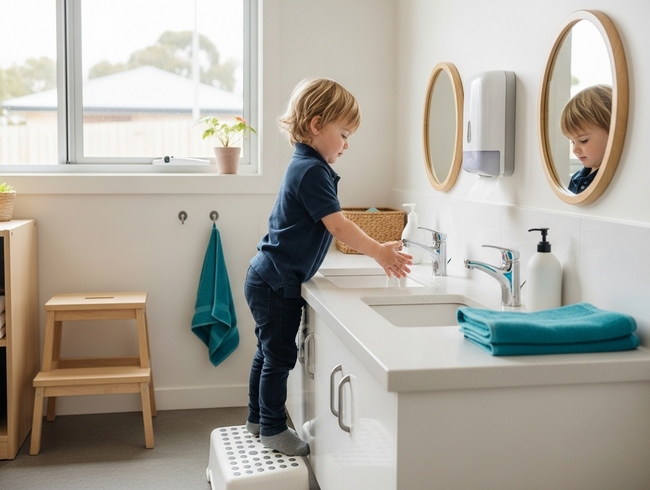
Routines provide the scaffolding that allows children to practice these skills in a low-stakes, supportive environment until they become second nature.
The Okinja Philosophy: The Rhythm of Nature, The Freedom of Play
A common fear is that routines in a group setting can become rigid and institutional. This is where philosophy and expertise make all the difference. Our approach is not about enforcing a strict clock, but about establishing a gentle, responsive daily rhythm that creates the perfect conditions for authentic, child-led play to flourish.
We see our daily rhythm as the banks of a river. The banks provide structure, safety, and direction, but within them, the water—the learning, play, and discovery—is free to flow, meander, and find its own path.
Rather than being confined by four walls, routines can be anchored in the natural world. A predictable “nature routine,” such as a morning journey to explore the Alex Forest Bushland Park or an afternoon ritual of checking on the vegetable garden, connects children’s daily rhythm to the larger rhythms of nature. This consistent, secure connection to the outdoors is a powerful way to foster both wellbeing and a deep respect for our local environment.
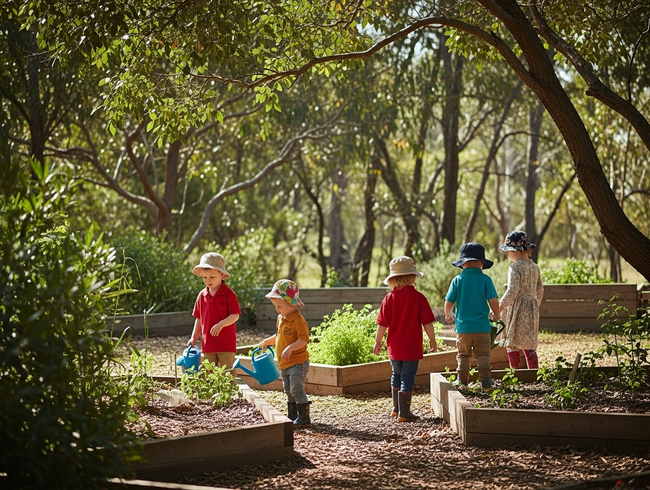
Furthermore, our purpose-built centre, with its four separate, age-appropriate playgrounds, allows us to tailor these rhythms to the specific developmental needs of each group. Routines for babies may be centred on responsive care and gentle transitions, while Kindergarten children engage in routines that foster collaboration, planning, and readiness for their next big step into formal schooling. This ensures that the structure provided is always a perfect fit, supporting rather than restricting each child’s individual journey.
Bringing the Rhythm Home: Practical Guidance for Your Family
The power of predictability is magnified when there is consistency between a child’s experience at our centre and at home. You don’t need a complicated, colour-coded chart. The most effective home routines are simple, consistent, and focused on connection.
- Morning Rituals: Instead of a rushed, chaotic start, create a simple, predictable sequence. For example: wake-up cuddle, get dressed, breakfast together, brush teeth, and then a special goodbye. Using a visual chart with pictures can be incredibly helpful for toddlers and preschoolers.
- Mealtime Moments: Try to have meals at roughly the same time each day. Involve your child in a simple part of the routine, like setting out the napkins or helping to wipe the table. This transforms a task into a moment of shared responsibility and connection.
- Bedtime Bliss: This is perhaps the most crucial routine of all. A predictable sequence—such as bath, pyjamas, brushing teeth, reading two books, a final cuddle, and then lights out—sends powerful cues to a child’s brain that it’s time to wind down and prepare for sleep. This consistency can be transformative for families struggling with bedtime battles.
The key is not perfection, but predictability. When your child knows what to expect, they feel more in control, leading to fewer power struggles and a more peaceful home environment for everyone.
The Okinja Promise: An Expert, Nurturing Framework for Your Child to Soar
At Okinja Early Learning Centre & Kindergarten, our commitment to evidence-based practice means we understand that routines are not about convenience for educators; they are a cornerstone of high-quality early childhood education. They are our way of creating a world that feels safe, nurturing, and perfectly designed to support your child’s emotional and cognitive growth. Our highly qualified educators are guided by the National Quality Framework to implement these daily rhythms with warmth, flexibility, and a deep understanding of each child’s individual needs.
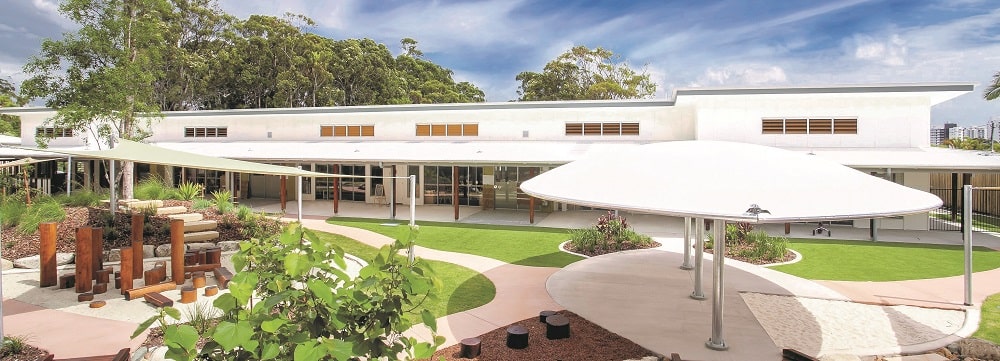
We invite you to see this philosophy in action. To observe the calm confidence of children who know they are safe, the joyful engagement of minds freed to learn, and the deep sense of belonging that comes from a predictable, loving environment.
If you’d like to discuss your child’s specific needs with our experienced, Bachelor-qualified educators, we invite you to book a tour. Contact Okinja Early Learning Centre today on 07 5479 2222 or email admin@okinjaelc.com.au to see how our expert-led, play-based approach can support your child’s journey.

